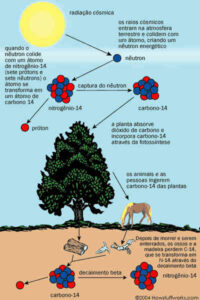“Cientistas apresentam novo método de datação por carbono 14 [Como funciona a datação por Carbono 14?] que poderia ser usado para avaliar objetos históricos (…) A famosa análise que determina a idade de artefatos antigos é muitas vezes rejeitada por museus e historiadores porque exige que um pedaço da peça seja removido.
O novo método, apresentado na terça feira [23 de março de 2010] durante o 239º Encontro Nacional da Sociedade Americana de Química (ACS) em São Francisco, dispensa essa e outras etapas que destroem parte da amostra. Ele foi criado por uma equipe liderada pelo Dr. Marvin Rowe, professor emérito da Universidade Texas A&M.
A datação de carbono convencional estima a idade de artefatos baseado na taxa de decaimento do isótopo radioativo carbono-14 – uma variante do carbono que existe em todos os seres vivos. Isso significa que todo material de origem animal ou vegetal (como tecidos, ossos, couro) pode ser datado por meio desse método. O primeiro passo é remover uma amostra dos objetos que será tratada com um ácido forte e uma base forte e, em seguida, queimada em uma pequena câmara de vidro. Esse processo irá produzir o gás dióxido de carbono cujo carbono 14 será analisado. Cientistas então comparam a quantidade do isótopo encontrada na amostra com a quantidade de C-14 que estaria presente na atmosfera de um período específico da historia.
em todos os seres vivos. Isso significa que todo material de origem animal ou vegetal (como tecidos, ossos, couro) pode ser datado por meio desse método. O primeiro passo é remover uma amostra dos objetos que será tratada com um ácido forte e uma base forte e, em seguida, queimada em uma pequena câmara de vidro. Esse processo irá produzir o gás dióxido de carbono cujo carbono 14 será analisado. Cientistas então comparam a quantidade do isótopo encontrada na amostra com a quantidade de C-14 que estaria presente na atmosfera de um período específico da historia.
Na nova técnica do dr. Rowe, chamado de ‘datação de carbono não destrutiva’, o artefato é colocado em uma câmara especial com um plasma (um gás eletricamente carregado). De forma lenta e suave, este gás oxida a superfície do objeto e produz carbono 14 para análise sem danificá-lo. Isso significa que o objeto não é mutilado. Os pesquisadores usaram o método para analisar cerca de 20 substâncias orgânicas que já haviam passado pela análise antiga, entre elas madeira, couro, pelo de coelho, um osso com carne mumificada e um tecido egípcio de 1.350 anos. Todos os resultados bateram com aqueles da datação convencional. Tanto o método antigo como o novo podem estimar objetos de até 50 mil anos. Como a câmara de vidro pode ser feita para acomodar grandes objetos, os pesquisadores estão entusiasmados com o método, que pode ser adotado para analisar objetos dos quais não é possível retirar freqüentes amostras…”
Fonte: Paula Rothman – INFO Online – 26 de março de 2010 – 09h44
New method could revolutionize dating of ancient treasures
“Scientists today described development of a new method to determine the age of ancient mummies, old artwork, and other relics without causing damage to these treasures of global cultural heritage. Reporting at the 239th National Meeting of the American Chemical Society (ACS), they said it could allow scientific analysis of hundreds of artifacts that until now were off limits because museums and private collectors did not want the objects damaged. ‘This technique stands to revolutionize radiocarbon dating,’ said Marvin Rowe, Ph.D., who led the research team. ‘It expands the possibility for analyzing extensive museum collections that have previously been off limits because of their rarity or intrinsic value and the destructive nature of the current method of radiocarbon dating’ (…) Rowe explained that the new method is a form of radiocarbon dating, the archaeologist’s standard tool to estimate the age of an object by measuring its content of naturally-occurring radioactive carbon. A professor emeritus at Texas A&M University College Station, Rowe teaches at a branch of the university in Qatar. Traditional carbon dating involves removing and burning small samples of the object. Although it sometimes requires taking minute samples of an object, even that damage may be unacceptable for some artifacts. The new method does not involve removing a sample of the object. Conventional carbon dating estimates the age of an artifact based on its content of carbon-14 (C-14), a naturally occurring, radioactive form of carbon. Comparing the C-14 levels in the object to levels of C-14 expected in the atmosphere for a particular historic period allows scientists to estimate the age of an artifact. Both the conventional and new carbon dating methods can determine the age of objects as far back as 45,000 to 50,000 years, Rowe said. In conventional dating methods, scientists remove a small sample from an object, such as a cloth or bone fragment. Then they treat the sample with a strong acid and a strong base and finally burn the sample in a small glass chamber to produce carbon dioxide gas to analyze its C-14 content. Rowe’s new method, called ‘non-destructive carbon dating,’ eliminates sampling, the destructive acid-base washes, and burning. In the new method, scientists place an entire artifact in a special chamber with a plasma, an electrically charged gas similar to gases used in big-screen plasma television displays. The gas slowly and gently oxidizes the surface of the object to produce carbon dioxide for C-14 analysis without damaging the surface, he said. Rowe and his colleagues used the technique to analyze the ages of about 20 different organic substances, including wood, charcoal, leather, rabbit hair, a bone with mummified flesh attached, and a 1,350-year-old Egyptian weaving. The results match those of conventional carbon dating techniques, they say (…) The scientists are currently refining the technique…”
Fonte: Phys.org – March 23, 2010
